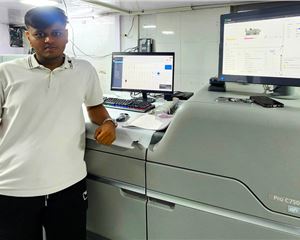Face to Face with Prof Dr Arved Hubler of Chemnitz University: The march towards nano technology
At a time, when mainstream discussion about packaging technologies chases a stifling path, Kiran Prayagi looks into the future of innovation along with Prof Dr Arved Hubler of Chemnitz University
09 Nov 2010 | By PrintWeek India
Kiran Prayagi (KP) What is the advantage of nano particles?
Arved Hubler (AH) It is stable in environmental conditions. Plus they are chemically stable and there is no aging. With polymers you have problems when it comes in contact with atmospheric conditions like oxygen and conditions such as UV exposure. They are not so stable. There are advantages and disadvantages with polymers. The main thing is the result.
KP In the future, will we see a combination of the two ...
AH Normally, you will see a combination of the two in use. It depends on the application and cost. Nano material needs a difficult process to manufacture and is expensive. Polymer is inexpensive, because it's plastic. The hope is, polymers become the bread and butter material – and for special functionality you use nano particles.
KP Nano particles are being used for key applications. What is the range of particle size in microns, and the capability of that small size to transfer into a conventional printing process?
AH The nano particle, as the name suggests, is below the micron scale. A typical size is one tenth of a micron. If you compare with the particles in the traditional printing business, it is not below a typical pigment. For example, the crystallite in a photo layer is also a nano particle.
KP What is the reason that makes nano particles so attractive?
AH In nano technology, the physics has evolved. For a silver particle the melting point is high, but with the nano particle, this is low. For 10 nano diameter, it will be 50 degrees celsius. This gives nano an advantage. It makes its possible to print with the conventional process. Therefore, you find nano particle inks which are curable at a low temperature.
KP What kind of experiments are you doing with offset, flexo, gravure, screen, digital?
AH Yes, all four traditional print processes are under discussion. In digital, it is only inkjet because in toner printing there is a lot of electrical properties to deal with. Hence to carry the toner particle, one has to make additional requirements which makes it difficult. But inkjet is very popular because it's easy for lab work; plus there are specific inkjet printers which are available for printed electronics.
KP Is it because inkjet has the speed and capability of mass production, like for bar coding applications?
AH There are colleagues of mine who have the idea that in 20 years time, we will be able to print our printed electronic requirement at home with inkjet. So you can print, the mobile phone at home. This is their vision. I don't believe this. And I don't see the reason for this. The main advantage of digital printing is to reduce quantity, and individualise. I want to put the element of individualisation in the layer – and not in the structure of my electronics.
KP Which conventional process suits nano technology?
AH Gravure is a favourite process with the guys who are dealing with printed electronics because you have to invest one time in a cylinder. It's expensive, but you print the same patterns (like transistors) and you do it for a year. The advantage with gravure is, you get homogenous layers; it offers morphology for the layers. Plus cost holds the key.
KP What about three dimensional electronics?
AH We have results in theory but to make multi-layer systems is a task. We need to get on the same basic area and do integration of a lot of transistors put foil by foil. This has hundreds of layers to create a block like a book block. It's a task to laminate such a block and get a powerful electronic device. Our benchmark is the human brain. The human brain has a single neuron. It is much slower and much larger than a transistor in a silicon chip but because it is three-dimensional, it is able to have a nuanced, complex functionality. Since silicon is two dimensional, you could never do a multi layer system. So that might be the way forward while developing printed electronic, in the future.
KP Has this technology reached production stage?
AH There are several companies which are claiming and showing samples. The main issue is that the really killer application is not available.
KP Are you searching for a successful market?
AH In Chemnitz we had a company, which printed systems like memory cards, but at the end they were not successful in introducing it. So we have to wait and see if there are new approaches. The main difficulty is, you not only meet the printed device and its functionality but you also need an interface to the world, to the internet to the RFID reader or to your computer. If you have electronic functionality, it has to interact with somebody and this interaction has to fulfill a business model. You have to find somebody who creates a business model for the whole chain from the printed electronic to the benefit for the user. And that's a crucial point. For every new technology, it needs infrastructure.
KP And right now, for printed electronics, there is nothing?
AH We need a real game-changing application which the world wants and is ready to pay for. That's not found so far.
KP There was interest shown by retail chain suppliers ...
AH That's an important market. But it's a very competitive market. For example, 2D code, bar-code pattern, you have the infrastructure available with your mobile. But you have disadvantages, because of the two dimensional pattern.
KP You were talking about bar codes. With gravure it could have a big advantage. Shoppers would see the graphical image which has a hidden code. What do you think?
AH That's true. It has hidden features. But it's no breakthrough. For example, we have a printed loud speaker. It is a fun element to have a piece of paper which acts as music. It is connected to a computer or amplifier through contacts and then the paper plays music (it was printed on gravure). It's a nice gimmick, but at the end it's a question who pays money for it and how do we find a real good application for it.
KP Is any machine manufacturer ahead in term of printing?
AH In our lab we have Manroland and Heidelberg presses among others. We have adopted a specific lab system from these companies, but that is for special technology and not for production. I think we have very good lab equipment and it has helped us a lot. But it does not mean any one company's press is ahead in terms of configuration.
KP Is one part of the problem that academics are thinking about applications which are far away from the marketplace?
AH I don't think so. The electronic guys study the iPhone and they come up with a high end alternative. Today, the traditional printers and press manufacturers do not deliver products ideas. They sometimes come and say I want to print 10-ups or print six extra colours. But that's not being creative. I feel, shrinking creativity is a problem. And so, we do not get inputs for future products. Today, it's only me and my students and some universities, who drive a new idea. Unfortunately, this excludes the traditional print firms or press manufacturers. And that's a problem for us.
KP They say, if you want to get money for research from public funds, a typical time-frame is three years?
AH True. And after three years, the people who fund the money want results. That is the way of the world. So, if you need money, you have to concoct short-term stories. This is a typical process not only for printed electronic but in other technologies too. In every technology development, there are small steps, they are not very attractive. It's a typical so-called 'S' curve of technology development where you have a starting point, you have to invest – and there is no result. And then at one point, normally you don't know when, it explodes and then you have strong growth and then the saturation point. Right now, there is a general interest. But most of the people are little afraid about this. Perhaps they don't understand.
Leading print companies register for second Indo German conference on technology and developments in packaging printing

Subscribe to RSS feeds
for the latest news














 See All
See All